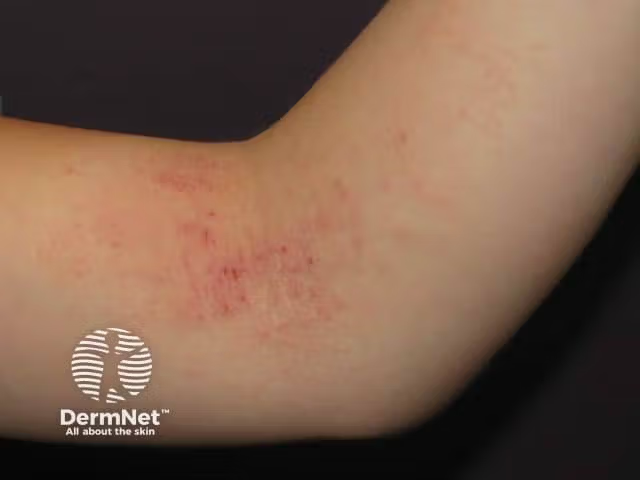- Case-Based Roundtable
- General Dermatology
- Eczema
- Chronic Hand Eczema
- Alopecia
- Aesthetics
- Vitiligo
- COVID-19
- Actinic Keratosis
- Precision Medicine and Biologics
- Rare Disease
- Wound Care
- Rosacea
- Psoriasis
- Psoriatic Arthritis
- Atopic Dermatitis
- Melasma
- NP and PA
- Skin Cancer
- Hidradenitis Suppurativa
- Drug Watch
- Pigmentary Disorders
- Acne
- Pediatric Dermatology
- Practice Management
- Prurigo Nodularis
- Buy-and-Bill
News
Article
Dermatology Times
FROM THE COVER: E-Cigarettes and Vaping - Clinical Implications of Dermapathology, Impact on Atopic Dermatitis
Author(s):
Researchers hypothesize that skin contact with e-cigarette fluids can trigger an inflammatory response.
Image Credit: © Aliaksandr Barouski - stock.adobe.com

Initially touted as a safer alternative to traditional smoking, vaping may not be without its own set of risks, including dermatological sequelae, mounting evidence suggests.1 Although the causality and the directionality of the association between atopic dermatitis (AD) and e-cigarette use is still under investigation, research continues to point to a link. For instance, in a study of 28,563 US adults, researchers found “a significant association between AD and e-cigarette use.”2 The researchers postulated the inflammatory response is caused when skin comes into contact with e-cigarette fluids, which have been linked with cytotoxic damage, or by the active ingredient propylene glycol, which can induce an inflammatory response.
“It is possible that individuals with AD are more likely to use e-cigarettes,” the researchers wrote, posing another connection. “It has been postulated that the emotional changes observed in those with AD may result in increased rates of smoking; therefore, the same may also hold true for e-cigarettes.”2
To better understand the dermatological burden of e-cigarettes and vaping, Peter Lio, MD, FAAD, and Kripa Ahuja, MS, conducted a comprehensive examination of the literature. Their findings and discussions were published in Journal of Integrative Dermatology.1
Exacerbation of Atopic Dermatitis
Prior research has highlighted the link between AD and e-cigarette use/vaping.3 Lio and Ahuja explained e-cigarette aerosols contain chemicals such as nicotine, propylene glycol, glycerol, and various flavoring agents, many of which have been implicated in skin irritation and inflammation. Exposure to these compounds can precipitate or exacerbate flares, resulting in heightened pruritus, erythema, and compromised skin barrier function.1
Role of Nicotine in Skin Inflammation
Lio and Ahuja emphasized the role of nicotine in perpetuating inflammation and oxidative stress in the skin.1 Nicotine has been shown to disrupt the skin’s natural defense mechanisms, impairing its ability to heal and regenerate. In patients with AD, this dysregulation of the skin’s innate immunity can further exacerbate disease severity and hinder treatment outcomes.
Skin Physiology and Oral Mucosal Health
The presence of certain flavoring agents also has been shown to induce cytotoxicity and inflammatory responses in skin cells, Lio and Ahuja noted.1 The oral mucosa, being the initial site of contact with e-cigarette vapors, is particularly vulnerable to damage. E-cigarette users exhibit a variety of lesions and mucosal impairments, including nicotine stomatitis, hyperplastic candidiasis, angular cheilitis, and black hairy tongue (BHT). Nicotine stomatitis presents with gray or white changes to the hard palate, potentially progressing to mucosal thickening and fissuring, while hyperplastic candidiasis manifests as white patches, likely due to changes in oral pH induced by e-cigarette chemicals. BHT results from desquamation of the dorsal tongue, possibly linked to e-cigarette–induced pH changes.1
Additionally, e-cigarettes are associated with lichen planus, oral lichenoid reactions, and acute epiglottitis, underscoring the need to stay vigilant for oral complications. Although e-cigarettes contain lower levels of arsenic compared to traditional cigarettes, the lack of FDA standards raises concerns about their true safety and highlights the importance of ongoing research.1
Inflammation and Immune Dysregulation
The review by Lio and Ahuja also explored the broader implications of vaping on systemic inflammation and immune dysregulation, which can have far-reaching consequences for patients with atopic dermatitis. Chronic exposure to e-cigarette aerosols has been linked to increased levels of pro-inflammatory cytokines and oxidative stress markers, both of which play pivotal roles in driving the pathogenesis of AD.1
Additionally, numerous studies have demonstrated an association between smoking and palmoplantar pustulosis (PPP), and it is oftentimes considered a subtype of psoriasis with many small, hyperkeratotic or pustular lesions primarily concentrated on the palms and soles.1 One study found almost 95% of participants with PPP had a history of smoking or were a current smoker.4 Lio and Ahuja explained that research has proposed nicotine from e-cigarettes is involved in the interplay of smoking and PPP via 2 mechanisms: increased cornification of keratinocytes in sweat glands and stimulation of neutrophils to produce IL-8, leading to neutrophil migration, leukocytosis in sweat glands, and subsequent inflammation.1 Moreover, smoke extract from e-cigarettes may directly lead to the release of pro-inflammatory IL-17 and IL-36, further exacerbating systemic inflammation and immune dysregulation.5

Secondhand Damage
Building on the foundations set by Lio and Ahuja as well as other investigators, a new study published in JAMA Dermatology explored the association between parental e-cigarette use with pediatric AD.6 Investigators from the Stanford University School of Medicine in Stanford, California, conducted a retrospective, cross-sectional analysis of the 2014-2018 National Health Interview Survey to elucidate this association. They hypothesized that the evidence from in vitro studies finding increased oxidative stress in human keratinocytes and 3-dimensional skin models exposed to e-cigarette fluids and aerosol residues play a similar role in secondhand damage as it does for adults. After adjusting for asthma, allergic rhinitis, respiratory allergies, parental smoking history, and sociodemographic factors, they found children who were exposed to parental e-cigarette use had higher odds of AD (adjusted odds ratio, 1.24; 95% CI, 1.08-1.42).
Implications for Clinical Practice
Educating patients about the risks of vaping is of utmost importance, and routine screening for vaping habits during assessments can identify potential exacerbating factors.1 Smoking cessation should be incorporated into treatment plans, and as appropriate, clinicians can offer support resources.
“Vaping among teens has increased tremendously in the past decade and often seems to be deemed healthier than smoking,” Lio told Dermatology Times. “While this may be true in some ways, it is by no means healthy. The risk of inhalation of toxins including heavy metals, volatile organic compounds, and ultrafine particles deep into the lungs is real.”
Lio, who is clinical assistant professor of dermatology and pediatrics at the Feinberg School of Medicine in Chicago, Illinois, added, “Skin issues including contact dermatitis, impaired wound healing, and oral mucosal lesions have been described. It is important to get the word out that vaping is not as innocent as it may have initially seemed.” Ongoing research and vigilance are crucial for staying informed and refining evidence-based guidelines to address the growing landscape of vaping-related dermatological concerns.
Isabella Tan is a third-year medical student at Rutgers Robert Wood Johnson Medical School in New Brunswick, New Jersey.
References
- Lio P, Ahuja K. A review of the dermatological manifestations associated with e-cigarettes and vaping. Journal of Integrative Dermatology. December 30, 2023. Accessed May 8, 2024. https://www.jintegrativederm.org/article/90982-a-review-of-the-dermatological-manifestations-associated-with-e-cigarettes-and-vaping
- Smith B, Engel P, Collier MR, et al. Association between electronic-cigarette use and atopic dermatitis among United States adults. J Am Acad Dermatol. 2023 Jul;89(1):163-165. doi: 10.1016/j.jaad.2023.02.027. Epub 2023 Feb 25. PMID: 36842506.
- Lee A, Lee SY, Lee KS. The use of heated tobacco products is associated with asthma, allergic rhinitis, and atopic dermatitis in Korean adolescents. Sci Rep. 2019;9(1):17699. doi:10.1038/s41598-019-54102-4
- Reddy V, Bhutani T. Palmoplantar pustulosis in electronic cigarette users: a potential for concern. Dermatology. 2019;235(6):525-526. doi:10.1159/000503385
- Kobayashi K, Kamekura R, Kato J, et al. Cigarette smoke underlies the pathogenesis of palmoplantar pustulosis via an IL-17A-induced production of IL-36γ in tonsillar epithelial cells. J Invest Dermatol. 2021;141(6):1533-1541.e4. doi:10.1016/j.jid.2020.09.028
- Youn GM, Sarin KY, Chiou AS, Chen JK, Honari G. Parental e-cigarette use and pediatric atopic dermatitis. JAMA Dermatol. 2024 May 22:e241283. doi: 10.1001/jamadermatol.2024.1283. Published online May 22, 2024. doi:10.1001/jamadermatol.2024.1283







